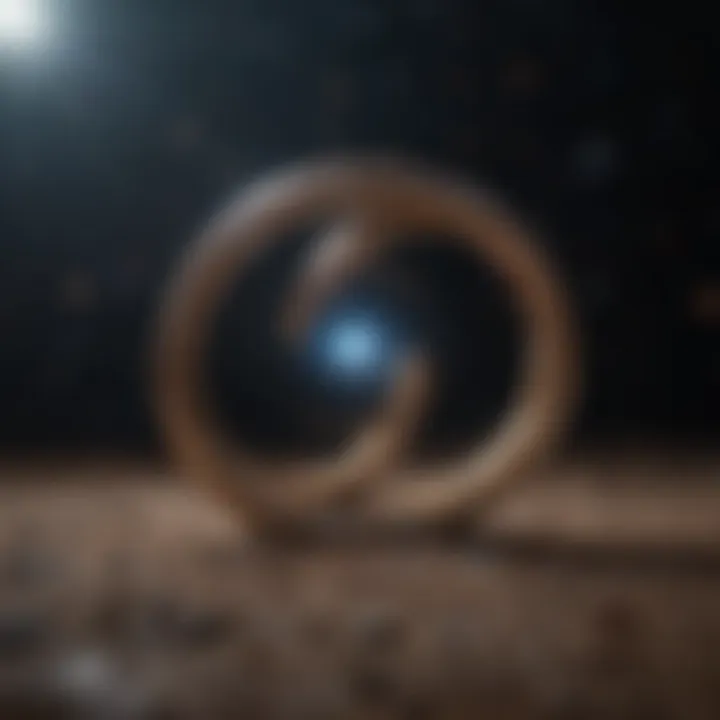Understanding Infinity: The Nature of Infinity Explained


Intro
Infinity is a concept that transcends the boundaries of conventional mathematics and ventures into philosophy. It prompts the mind to ponder infinite possibilities and the nature of numerals. In this exploration, we will examine infinity not merely as a number but as an idea that influences various disciplines such as mathematics and physics.
Through our discussion, we will uncover the origins of infinity, its multiple definitions, and its significance in academia and beyond. By addressing common misconceptions surrounding infinity, we aim to provide clarity on this complex topic. Our target audience includes students, educators, researchers, and professionals, all of whom have a vested interest in understanding the nuances of infinity.
Understanding infinity is not just an academic exercise; it shapes how we perceive the universe and numerical systems. As we progress through this article, you will see how infinity interconnects with various fields and influences theoretical frameworks. This narrative will guide you through the layers of complexity surrounding infinity, making it approachable for a diverse readership.
Key Research Findings
Overview of Recent Discoveries
Recent explorations in mathematics have shed new light on the concept of infinity. Researchers have developed sophisticated models to analyze infinite sets and their implications. One significant discovery includes Cantor's work on different sizes of infinity. His theory revealed that some infinities are larger than others, which revolutionized the way mathematicians understand the continuum of numbers.
In addition, advances in physics have explored how infinity appears in various theories concerning the universe, such as the Big Bang and black holes. These discussions often evoke curiosity about the boundaries of our universe and whether infinite existence is feasible.
Significance of Findings in the Field
The findings in both mathematics and physics illuminate infinity's expansive nature. They challenge existing assumptions and encourage theoretical developments in numerous domains. This has a ripple effect, informing not only mathematical theories but also philosophical inquiries about existence. As scholars continue to dissect the concept, infinity might reshape our understanding of reality.
"Infinity is not just a concept; it is a gateway to understanding the universe in ways we have yet to fully comprehend."
Breakdown of Complex Concepts
Simplification of Advanced Theories
To grasp the essence of infinity, it is essential to simplify advanced theories. The concept of limit in calculus gives one a practical sense of infinity. For instance, when we approach a limit, we are often dealing with infinite processes. This way, infinity becomes a valuable tool for understanding continuous functions and their behaviors.
Visual Aids and Infographics
Utilizing visual aids can enhance comprehension of infinity. Diagrams illustrating Cantor’s hierarchy or the infinite series in mathematics can solidify understanding. For example, consider the illustration of the number line stretching to infinity in both directions. This visual not only represents infinity but also situates it within familiar numerical contexts.
Preamble to Infinity
Infinity stands as a significant concept in both mathematics and philosophy, influencing how we perceive numbers and the universe. It serves as a reminder that there are boundaries to what we can comprehend. The exploration of infinity provides insights into not only numerical systems but also challenges our understanding of limits and continuity. Here, we will examine key elements surrounding infinity, including definitions, historical context, and its philosophical implications.
Definition of Infinity
Infinity is often defined as an idea rather than a specific number. It embodies the notion of endlessness or an unbounded quantity. Mathematically, it is represented by the symbol ( \infty ). However, several different contexts illustrate how the term is applied:
- In calculus, infinity frequently appears in limits, indicating values that grow beyond any finite quantity.
- In set theory, infinity can describe the size of sets that cannot be enumerated.
The ambiguity surrounding this term highlights its complexity. Many engage with infinity intuitively, yet its rigorous definition remains elusive.
Historical Context
The concept of infinity has a rich history, tracing back to ancient civilizations. The Greeks, particularly mathematicians like Zeno of Elea, scrutinized infinity through paradoxes that questioned the foundations of continuity and quantity. Later, thinkers such as Galileo examined infinite sets but did not classify them mathematically.
In the 17th century, mathematicians like John Wallis began to use the symbol for infinity in their work. The formalization of infinity in mathematics advanced dramatically in the 19th century thanks to Georg Cantor. He introduced the idea of transfinite numbers, which expanded how mathematicians understand different sizes of infinity. This progression illustrates the transformation of infinity from a philosophical concept to a cornerstone in modern mathematics.
Philosophical Implications


Beyond mathematics, infinity carries significant philosophical weight. It prompts inquiries about the nature of existence, time, and the universe. For instance, if the universe is infinite, does it have no beginning or end? Philosophers such as Immanuel Kant pondered the implications of infinity on human cognition and whether humans can truly grasp it.
The concept also raises ethical considerations. If infinity suggests limitless possibilities, how does this affect our moral choices and responsibilities? This intersection between infinity, ethics, and philosophy illustrates its profound and multifaceted impact on human thought.
"Infinity is a concept that continually challenges the boundaries of understanding; it forces us to reassess what we believe is possible."
Overall, the study of infinity enriches our intellectual landscape. It merges mathematical rigor with philosophical inquiry, resulting in a deeper appreciation for numbers and the universe. Understanding infinity forms the foundation for further exploration in subsequent sections of this article.
Infinity in Mathematics
Infinity is a critical concept that serves as a bridge between abstract thought and rigorous mathematical analysis. It prompts profound questions regarding the nature of numbers and limits, influencing the way mathematicians approach problems. Understanding infinity is essential for grasping various mathematical theories, especially in fields such as calculus and set theory. This section will explore three main aspects: infinity in set theory, the role of limits in calculus, and the implications of Cantor's theorems.
Infinity in Set Theory
Set theory approaches infinity through the lens of collections of objects. Here, infinity is not simply a number; rather, it represents the size of a set that cannot be quantified by traditional means. For instance, consider the set of natural numbers: 1, 2, 3, and so forth. This set is infinite because no end exists to its count.
Some key points include:
- Countability: Sets can be either countably infinite or uncountably infinite. A countably infinite set can be put into a one-to-one correspondence with the natural numbers, while an uncountably infinite set cannot.
- Example: The set of real numbers between 0 and 1 is uncountably infinite. You cannot list all real numbers in that interval even though they exist in infinite quantity.
- Zermelo-Fraenkel Axioms: These axioms form the foundation of modern set theory, allowing mathematicians to work with different sizes of infinity systematically.
Understanding infinity in set theory challenges conventional perceptions and lays the groundwork for much of modern mathematics.
Limits and Calculus
In calculus, the concept of limits is integral for dealing with infinity. Limits allow mathematicians to evaluate functions as they approach a value, which is essential when confronting indeterminate forms. For example, when analyzing a function that tends to infinity, we can describe its behavior approaching that point while never actually reaching it.
- Approaching Infinity: An example is the function f(x) = 1/x. As x approaches 0, f(x) tends to infinity. This behavior reveals the relationship between variables and their limits.
- L'Hôpital's Rule: This rule is employed to resolve indeterminate forms like 0/0 or ∞/∞ by taking derivatives. It reinforces the idea that infinity, in this context, gives a deeper insight into function behavior.
Limit operations demonstrate how infinity interacts with calculus, showcasing infinity’s role as a crucial tool for mathematical analysis.
Cantor's Theorem
Cantor's contributions fundamentally reshaped the understanding of infinity. His theorem established not just the existence of different sizes of infinity, but also provided a way to comprehend them. This theorem allows mathematicians to classify infinite sets based on their cardinality.
- Cardinality of Sets: Cantor introduced the concept of cardinality as a measure of a set's size, even when that size is infinite. For example, while the natural numbers are countably infinite, the real numbers are of a greater cardinality.
- Proof by Diagonalization: Cantor's diagonal argument establishes that the set of real numbers cannot be matched one-to-one with the natural numbers. This counterintuitive proof demonstrates that there are more real numbers than natural numbers.
Cantor's work has profound implications, revealing the complexity of infinity in a way that reshapes modern mathematical thought.
Through these three topics, it is clear that infinity in mathematics is not an abstract idea subsisting in isolation; it is deeply intertwined with fundamental principles and theories. Understanding infinity lays a solid groundwork for further exploration into both mathematical and philosophical interpretations.
Types of Infinity
The exploration of types of infinity is essential in understanding this complex concept. Infinity is not a singular entity; rather, it encompasses a spectrum of infinities. Each type offers its own unique implications for mathematics and philosophy. This section aims to clarify these distinctions and their relevance in a broader context. Understanding the different types of infinity equips scholars with deeper insights into both theoretical constructs and practical applications.
Countable and Uncountable Infinity
Countable infinity refers to a set that can be put into a one-to-one correspondence with the natural numbers. This means that, despite being infinite, such sets can be enumerated. Examples of countable infinity include the set of rational numbers and the set of integers.
In contrast, uncountable infinity represents a larger or more complex structure that cannot be listed in this manner. The set of real numbers is a prime example, as it contains intervals of numbers that cannot be easily quantified with natural numbers.
Key points on countable and uncountable infinity include:


- Countable Infinity Examples: Integers, rational numbers.
- Uncountable Infinity Examples: Real numbers, irrational numbers.
- Significance: Understanding this difference helps in grasping the diverse landscapes of infinite sets.
"Not all infinities are created equal; some are indeed larger than others."
Infinity in Different Spaces
The concept of infinity can manifest variably in different mathematical spaces. For instance, in topology, a topological space may exhibit properties or structures that relate to infinity in unique ways. In Euclidean space, points at infinity can be conceptually added to create a more comprehensive system, such as the extended real number line.
Also, projective geometry introduces an idea of infinity that is distinct from traditional Euclidean views.
Important considerations include:
- Geometric Spaces: Different representations of infinity can help solve complex geometrical problems.
- Topological Implications: The nature of infinity often affects convergence and continuity in these spaces.
Transfinite Numbers
Transfinite numbers, introduced by mathematician Georg Cantor, bring a systematic approach to discussing different sizes of infinity. These numbers allow mathematicians to compare infinities in a meaningful way. Transfinite numbers include aleph-null (ℵ₀), the cardinality of countably infinite sets, and larger cardinalities that represent uncountable sets.
Transfinite arithmetic leads to surprising results. For example, adding or multiplying transfinite numbers can yield unexpected outputs. Educators and researchers should consider:
- Cardinal Numbers: Understanding the measures of different types of infinite sets.
- Ordinal Numbers: Representing the order type of a well-ordered set.
- Applications: Insights gained from transfinite numbers can elucidate topics in set theory and mathematical logic.
By grasping the types of infinity, one can appreciate the profound complexities that emerge within mathematics and philosophy. The distinctions highlight how infinity is intertwined within our comprehension of numerical systems and the very fabric of reality.
Infinity in Physics
The concept of infinity plays a crucial role in physics, challenging our understanding of the universe and its laws. Infinite quantities often arise in various theories, leading to profound implications for both theoretical frameworks and practical applications. Examining infinity helps physicists address fundamental questions about space, time, and matter.
Concept of Infinite Space
Infinite space suggests a universe without boundaries. This idea can be both stimulating and troubling. If space is infinite, the implications for matter and energy become significant. It leads to questions about the nature of the cosmos. Are galaxies and stars arranged in a certain pattern or scattered randomly? An infinite universe poses challenges to our understanding of gravity and cosmic structures.
In modern cosmology, the assumption of an infinite universe has been integrated into models such as the Friedmann-Lemaître-Robertson-Walker metric. This model explores how space might expand infinitely, giving rise to the concept of an expanding universe. With infinite volume, the gravitational interactions among celestial bodies become a complex topic to study.
"An infinite universe opens up endless possibilities, and the implications are as vast as space itself."
Black Holes and Singularities
Black holes epitomize the intersection of infinity and physics. Within a black hole lies a singularity, a point where the density becomes infinite, and the laws of physics as we know them cease to function. This presents a paradox within our understanding. How can existing theories hold in such extreme conditions?
The event horizon of a black hole creates a boundary beyond which nothing can escape. This leads to yet another question about infinity. While space may seem finite, what lies beyond a black hole? Does space continue infinitely, or is it a closed loop? Theories continue to be developed to approach these mysteries, but questions of infinity remain.
The Universe and Infinite Scale
The universe itself is thought to operate on scales that can be both finite and infinite. At the cosmic scale, phenomena such as dark matter and dark energy suggest dimensions we cannot perceive, hinting at an infinite nature. On a smaller scale, quantum physics presents its own paradoxes involving infinity, as seen with concepts like quantum entanglement and virtual particles.
Understanding the universe requires grappling with both the finite and infinite. The observable universe is limited by the speed of light and the age of the cosmos, yet we suspect infinity lies beyond our perception. This contradiction drives research into cosmological models and expands our quest for knowledge.
Exploring infinity in physics encourages thinkers to look beyond established boundaries. Discussions about infinity help unravel the complexities of the cosmos, inspiring both scientific inquiry and philosophical debate.
Common Misconceptions about Infinity


Infinity is a concept that evokes curiosity as well as confusion. Understanding its nuanced misconceptions can lead to a clearer grasp of its true nature. This section aims to clarify prevalent misunderstandings regarding infinity, enhancing our overall grasp of mathematics, philosophy, and the universe.
Infinity as a Number
Many people mistakenly regard infinity as if it were a conventional number. In numerical systems like the integers or real numbers, we can perform various operations. However, infinity is not a specific value but rather a conceptual idea representing an unbounded quantity or size. It does not operate in the same manner as finite numbers.
For example, one cannot say that infinity plus one equals a number. Instead, one must understand that operations involving infinity lead to different results than expected in traditional arithmetic. When we encounter expressions such as ( extinfinity + 1 ), the outcome remains simply infinity. This illustrates the difference between infinite sizes versus finite calculations.
Thus, it is crucial to grasp that infinity, while often represented in equations, does not equate to a real number that can be manipulated in the same way other numbers can. A more accurate view is that infinity represents potential or ongoing processes rather than a fnite endpoint to calculations.
Endless Processes and Infinity
The notion of infinity is frequently intertwined with the idea of endless processes, such as counting or performing calculations without limitation. While it is true that many processes can extend indefinitely, the misconception arises when one assumes that such processes can effectively reach or become infinity.
For instance, in calculus, we often encounter the concept of limits that approach infinity. However, reaching infinity is not possible; rather, it represents a behavior of certain functions or sequences as they grow larger without bounds. Here, infinity serves as a destination toward which we can approach but never actually attain.
"Infinity is not a number, but a notion of unboundedness, a way to describe the limitless nature of certain mathematical constructs."
Infinity in Everyday Life
The concept of infinity transcends mathematics and philosophy. It impacts various aspects of daily life, shaping how we think, reason, and understand our world. Understanding infinity helps individuals grasp the limits of human comprehension and the implications for technology and computing.
Limits of Human Understanding
Humans have finite brains. We struggle to comprehend the infinite. Yet, we use the idea of infinity regularly. For instance, in discussions about time and space, we often refer to endlessness. This lack of grasp can lead to misconceptions. Many believe infinity is a specific entity, but it is more of a concept.
For example, one can think about infinite sequences, like the series of natural numbers. Though the sequence can extend endlessly, we can only reach finite numbers. This paradox highlights the limits of our mental capacity. Acknowledging this limitation urges individuals to adopt a more profound appreciation for infinity.
"Infinity is not a number; it is a concept that challenges our understanding of reality."
Infinity in Computing
In the realm of computing, infinity plays a crucial role. Programmers deal with infinite loops and algorithms requiring careful handling of extensive data sets. Infinity in this context enhances the performance of computations and can be used to define concepts, such as overflow errors.
In coding languages like Python, infinity can be represented by . This means it can help define bounds in calculations or comparisons.
For instance, algorithms often utilize infinity as a sentinel value. This aids in determining the minimum or maximum values dynamically without being bound by real numbers.
Infinity also emerges in database systems where data retrieval processes must anticipate extensive ranges of values. This characteristic can guide developers in optimizing applications. Understanding infinity in computing ensures that applications function correctly under varying conditions, enhancing user experiences across the digital landscape.
In summary, infinity is not merely an abstract concept isolated from daily tasks. Its implications inform technology development and challenge our cognitive limits, enriching our understanding of both the universe and our relationship with it.
Closure: Embracing the Concept of Infinity
The exploration of infinity concludes in recognition of its vast significance and profound implications. Throughout the article, we have delved into how infinity permeates various domains such as mathematics and philosophy. Grasping the concept of infinity helps to demystify its complex nature and wide-ranging applications. Understanding infinity leads to a deeper appreciation of numerical systems, the universe, and our own cognitive limitations.
As we ponder the infinite, we can begin to see its effects on our scientific inquiries and philosophical debates. The considerations surrounding infinity are not merely academic; they speak to the human experience itself, pushing the boundaries of what we accept as conceivable.
The Impact of Infinity on Science and Philosophy
Infinity serves as a crucial element in both scientific inquiry and philosophical thought. In science, the concept of infinite numbers can lead to more profound understanding in fields such as physics, where infinite models may apply to the universe’s geometry or its possible origins. Here are a few notable impacts:
- Mathematical Models: Infinity is essential in calculus and statistics. Concepts like limits and integrals depend fundamentally on approaching infinity, allowing for solving problems that account for infinite quantities.
- Philosophical Inquiry: Philosophers have mused on the implications of infinity for centuries. Is the universe infinite? What does an infinite number of realities mean for our understanding of existence?
- Scientific Paradigms: Infinity challenges conventional paradigms. When dealing with black holes and singularities, for instance, we encounter theories that stretch the limits of our understanding.
"Infinity is not a number, but a concept that stretches our grasp of reality".















